#Source Nepal
Explore tagged Tumblr posts
Text


#galidor#lol at the source commentary on the first pic#pretty sure Nepol was named after the country Nepal but yeah
0 notes
Text
question for any and all of my south asian pals: what are some fashion related things you love from your region, and could i use them as part of a design for a sci-fi/fantasy oc?
(also i love listening to people yap about their culture, so it doesn't even have to be about fashion)
#tbh i want to hear more about the not-as-well-known or as popular (for a lack of a better word) items#like i can get plenty of resources on indian styles but i doubt it would include all of india#the other countries are even harder to find reliable sources#or on the niche stuff#like how henna styles are different across countries#i do nawt trust articles bc they never get anything right about *my* culture#i don't think i can trust any source except from a local#south asia#bhutan#nepal#bangladesh#india#maldives#sri lanka#pakistan#keyo talks#orginal character#oc#writing
0 notes
Text
From the article:
Seven countries now generate nearly all of their electricity from renewable energy sources according to newly compiled figures. Albania, Bhutan, Nepal, Paraguay, Iceland, Ethiopia and the Democratic Republic of Congo produced more than 99.7 per cent of the electricity they consumed using geothermal, hydro, solar or wind power. Data from the International Energy Agency (IEA) and International Renewable Energy Agency (IRENA) also revealed that a further 40 countries generated at least 50 per cent of the electricity they consumed from renewable energy technologies in 2021 and 2022 – including 11 European countries.
#renewable energy#green energy#sustainable energy#fossil fuels#climate change#global warming#environment#climate anxiety#ecoanxiety#ecogrief#climate grief#good news#hope#hopepunk#solarpunk#newyears2025#solar energy#geothermal energy#hydroelectric#wind energy
2K notes
·
View notes
Text
"Empowering Change: The Call to Provide Financial Support for Transformation"
With poor policies in place, donors’ grants to support solar rooftops undermine the case for policy reform. Money doesn’t always buy love. It almost certainly never buys change. If deployed correctly, however, it has immense potential to influence change. Nepal’s development partners should take heed of this universal truth. They must reposition their generous aid so that it leads to systemic…

View On WordPress
0 notes
Text
The Best News of Last Month - August 2024
1.Negative Power Prices Hit Europe as Renewable Energy Floods the Grid

European power markets are experiencing a notable shift as renewable energy sources, particularly wind and solar, become a larger part of the energy mix. On Wednesday, power prices in several European markets, including Germany, dipped below zero due to a surge in green electricity production.
2. Taiwan introduces ban on performances by captive wild animals

Live performances by wild animals held in captivity, including performances by dolphins, tigers, and other non-domesticated mammals, will no longer be permitted in Taiwan under new Ministry of Agriculture (MOA) regulations.
3. FTC bans fake online reviews, inflated social media influence; rule takes effect in October

The FTC voted unanimously to ban marketers from using fake reviews, such as those generated with AI technology, and other misleading advertising practices.
The ban also forbids marketers from exaggerating their own influence by, for example, paying for bots to inflate their follower count.
4. Chinese drones will fly trash out of Everest slopes

Come autumn, Nepal will deploy heavy lifter drones to transport garbage from the 6,812-metre tall Ama Dablam, south of Everest. This will be the first commercial work an unmanned aerial vehicle does in Nepal’s high-altitude zone.
The heavy lifter from China’s biggest drone maker, Da Jiang Innovations (DJI), will take on tasks traditionally handled by Sherpas. Officials believe it will help reduce casualties on Everest.
5. Swiss scientists have found a way to use the whole cocoa fruit to make chocolate and not just taking beans and discarding the rest.

Kim Mishra (L) and Anian Schreiber (R) cooperated on the new chocolate making process
Food scientists in Switzerland have come up with a way to make chocolate using the entire cocoa fruit rather than just the beans - and without using sugar.
The chocolate, developed at Zurich’s prestigious Federal Institute of Technology by scientist Kim Mishra and his team includes the cocoa fruit pulp, the juice, and the husk, or endocarp.
6. Six-year-old boy found in Vietnam forest after five days

A six-year-old boy who was missing for five days has been found deep in a forest in Vietnam. Dang Tien Lam, who lives in the northwestern Yen Bai province, was playing in a stream with his nine siblings on 17 August when he wandered into the hills and got lost, local reports said.
He was found on Wednesday by local farmers who heard a child's cry while they were clearing a cinnamon field close to the forest.
7. Lego plans to make half the plastic in bricks from renewable materials by 2026

Lego plans to make half the plastic in its bricks from renewable or recycled material rather than fossil fuels by 2026, in its latest effort to ensure its toys are more environmentally friendly.
The Danish company last year ditched efforts to make bricks entirely from recycled bottles because of cost and production issues. At the moment, 22% of the material in its colourful bricks is not made from fossil fuels.
----------
That's it for this month :)
This newsletter will always be free. If you liked this post you can support me with a small kofi donation here:
Buy me a coffee ❤️
Also don’t forget to share this post with your friends.
1K notes
·
View notes
Text
Evidence that Kabru from Delicious in Dungeon is Indian, a Masterpost
(EDIT: This post is an excerpt/remix of Kabru's section of my larger essay about the real world linguistic and cultural references Dungeon Meshi. You can read the essay on AO3 here. I also have another post about what part of South Asia I think Utaya is based on here.)
Since Kabru’s first appearance in the anime is upon us, I wanted to write something that compiles all the evidence we have that Kabru is meant to be a person of South or Central Asian ethnicity, or at least whatever the equivalent to that is in the Dungeon Meshi world.
Ryoko Kui can and does draw people of many different ethnicities, and the way she draws Kabru matches the way she draws other Asian characters in Dungeon Meshi. He doesn’t look Black, or Hispanic, or any other ethnicity because he isn’t supposed to. He looks like a dark-skinned South or Central Asian person, because that’s what Ryoko Kui probably intends him to be.
So let’s go through the evidence! (There are no spoilers for the plot of Dungeon Meshi below, but there ARE spoilers for Kabru's backstory as explained in the manga, and in extra materials like the Daydream Hour and Adventurer's Guide book.)
KABRU’S NAME
The Dungeon Meshi Adventurer's Bible tells us Kabru’s real name is unknown. There are other characters whose real names are only told to us in the Adventurer's Bible and were never revealed in the manga, but then Kabru, Thistle and Izutsumi’s entries simply say their real names are unknown, and though Kui could tell us their true names, she doesn’t. I assume this means that the characters themselves don’t know what their real names are, and that the names they go by are not their birth names, but this is only a supposition on my part.
KABRU THE MOUNTAIN
Kabru (काब्रु) is the name of a mountain on the border of Nepal and India, and part of the Himalayan range. It’s the 65th tallest mountain in the world and it is very snowy and icy, with frequent avalanches. Because of this, even though it’s not the tallest mountain in the world, climbing it is challenging, and is not often attempted. Those few that have managed to climb it consider it a major achievement.
“This prohibitively fearful icefall… had thwarted numerous expeditions, perhaps even the 'thought' of attempting the mountain… Unstable seracs of the icefall, a complex maze of chasms, and delicate snow bridges spanning seemingly never ending, near bottomless crevasses… Each time the members stepped into the icefall, they stood a good chance of never returning.” (Kabru - Mountain of the Gods, Major A. Abbey, Himalayan Journal 52, 1996, editor Harish Kapadia)
WHAT DOES KABRU’S NAME MEAN?
Kabru is a character that is known for being very good at charming people, but who doesn’t express himself honestly, because he’s trying to manipulate the people and situations around him in order to maintain control at all times. I think nobody really knows who Kabru is deep inside, maybe not even Kabru himself, so a remote, hostile, icy mountain that’s hard to climb seems like an extremely appropriate name.
Some of the oldest English sources I found regarding Kabru suggest that Kabru isn’t the correct local name for the mountain (a common problem in early Himalayan exploration by Europeans) and might just be a descriptor, or that it’s a misspelling.
This makes the name seem even more appropriate, since Kui’s told us Kabru’s true name is unknown. It’s possible that Kabru was a place-name or a descriptor that Milsiril (Kabru’s elven foster mother) was given when she picked up a traumatized 7 year old Kabru, and she just started using it as his name, and that even he doesn’t remember his real name thanks to his severe trauma.
The fact that people in the real world can’t seem to agree on the mountain Kabru’s name, or what it means, reminds me of the running gag of Laios repeatedly getting Kabru’s name wrong in the manga.
"All the people near the Kabru massif call it 'Kaboor'." (The Alpine Journal, 1921-22 Volume 34, Edited by George Yeld and J. P. Farrar) “It is also said that the name applies to a peak close to Kinchinjunga on the southeast, and not to the peak known to Europeans as Kabru… [The real name is] Pahung Ri [Pauhunri].” (Appendix I: Place Names in Darjeeling. The appendix says it was “compiled mainly from an article written by Colonel Waddell and published in the Journal of the Asiatic Society of Bengal (Vol. LX, part I, 1891)”) “Kangchen is a Tibetan name… the Sikkhimese use it as the name for the peak called Kabru by Europeans.” (Charles Bell, Dyhrenfurth's Himalaya (Berlin, 1931)) “...Kyabru or the horn of protection. The name is… Kabur… possibly a corruption of Kangbur or the swelling of snow; it might also mean the white swelling (kar-bur).” (Appendix I: Place Names in Darjeeling.) “Kabru literally means the 'White Avalanche' peak (Ka means 'white' and bru means 'avalanche').” (Kabru - Mountain of the Gods, Major A. Abbey, Himalayan Journal 52, 1996, editor Harish Kapadia)
I’ve seen one other mountaineering article cite the “white avalanche” meaning, and I think it’s plausible since the Appendix says it can mean “white swelling” or “swelling of snow”, which may very well be a literal translation for “white avalanche”.
WHAT ABOUT UTAYA? IS THAT INDIAN TOO?
Utaya means “raised” or “uplifted” in Hindi, but it’s also a real village and a Japanese boy’s name.
Utaya (ウタヤ) is the name of the village that Kabru was raised in before his mother died and he was adopted by the elf Milsiril. Utaya is located in the southeast of the Western Continent. It’s worth noting that Kabru probably wasn’t born in Utaya, since his mother had to flee from her home to keep Kabru alive, so Utaya may be some distance away from his birth place… Not so far that a woman with a newborn baby couldn’t survive the trip, but far enough that her husband’s family gave up on chasing her. So Kabru was probably born in a close-by area.
In the real world, Utaya (Yakut: Утайа) is in an extremely rural and isolated area with a population of less than a hundred people. It’s located in the Sakha Republic, which is in the Northeastern part of Asia in the Russian Federation. The Yakut/Sakha are a Siberian Turkic people.
The Turkic peoples are a collection of diverse ethnic groups of West, Central, East, and North Asia as well as parts of Europe, who speak Turkic languages.
Early and medieval Turkic groups exhibited a wide range of both East Asian and West-Eurasian physical appearances and genetic origins, in part through long-term contact with neighboring peoples such as Iranian, Mongolic, Tocharian, Uralic/Yeniseian peoples, and others. Turkic peoples share, to varying degrees, non-linguistic characteristics like cultural traits, ancestry from a common gene pool, and historical experiences.
JAPANESE MEANINGS FOR UTAYA
Utaya can be a Japanese boy’s name with several different meanings, depending on which kanji it’s spelled with. In most of the spellings: Poetry, sing a poem, singing, compose poetry
In many of the spellings: The place where the sun shines, it's been a long time, distant, big, to shoot with a bow, to swear, affirmation, question.
The Utaya disaster happened a long time ago.
If Utaya is up in the mountains above the clouds it’s a place where the sun shines brightly.
Kabru has sworn to himself that he will prevent another Utaya tragedy from happening.
In only a few of the spellings: to mend, feathers, wings, a word for counting birds and rabbits, sort them out, washing with water to separate the good from the bad, roof, house with a roof, a world covered with a big sky, infinite space, song that praises the Buddha, Eight.
Counting birds and rabbits makes me think of divination and also that the people of Utaya were like little birds and rabbits (small prey animals) to the monsters that devoured them.
Separating the good and the bad could hint to the “judgment” of Utaya and the greed of its people that led to their downfall, also sorting through things to separate good and bad is something that’s done with food and other resources.
The Himalayan region is often referred to as the “roof of the world”, with a big open sky above it.
The infinite could refer to the dimension the demon comes from, or to the sky above the mountains.
Buddhism is a common religion in the Himalayan region, and eight has auspicious connotations in Buddhism.
With all that in mind, Utaya as a name for Kabru’s home village is an interesting choice, and adds another layer to his origins, maybe suggesting not just North Indian/Himalayan, but Central or North Asian cultural influence as well.
It is also possible that the name is just telling us that Utaya is “up” in the mountains, or that it was “uplifted” by the wealth of the dungeon, or even that Kabru was “raised” there… The Japanese name meanings are also extremely fascinating and hint at similar ideas, as well as the tragedy that happened to Utaya.
WHY ELSE DO YOU THINK KABRU AND UTAYA ARE HIMALAYAN?
In the real world, the Himalayan mountain range is an extremely popular tourist destination, and the amount of people who want to visit and attempt to climb the mountains far outpaces the local ability to support it. This makes me think of the dungeon of Utaya and how people overcrowded it in their desire to conquer and exploit it.
Dungeons as an unsustainable way for locals to make a living that leads to the destruction of their homes when the dungeon inevitably collapses is a major plot point in Dungeon Meshi, so I think the parallel is likely intentional. Characters often talk about someone “conquering” the dungeon, and “conquer” is also the terminology commonly used for climbing a mountain. This terminology obviously has a hostile, imperialist subtext in the real world, since it’s most commonly used by outsiders talking about proving their strength by climbing a mountain.
Also, there are local legends in the areas surrounding Mt. Kabru that there is a valley of immortality hidden on its slopes, which reminds me of the way that the dungeons can grant conditional immortality to the people inside of them.
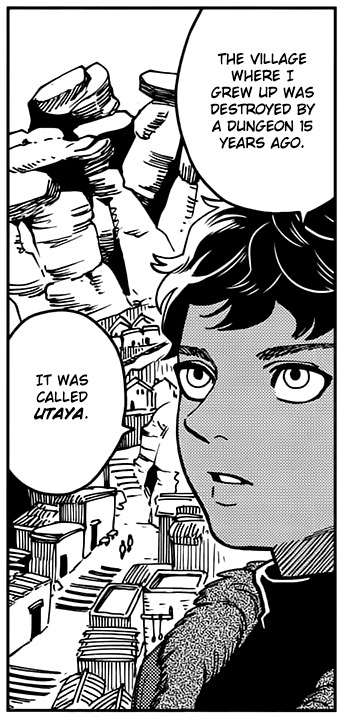
This image of Utaya could be showing us a village built on a mountainside. The house shapes seem a bit more Middle Eastern than Nepali/Indian, but it’s not a detailed drawing and the roof styles are a mix of flat and peaked.
CULTURE
In the Daydream Hour sketchbook, Ryoko Kui included a small comic about characters sharing desserts from their home countries. A young Kabru is shown enthusiastically trying to share an unnamed sweet, and he is interrupted by his elven foster mother, who insists he present a type of elven cake instead. We know that Kabru hates this type of cake, and he seems disappointed to have to eat it and talk about it.
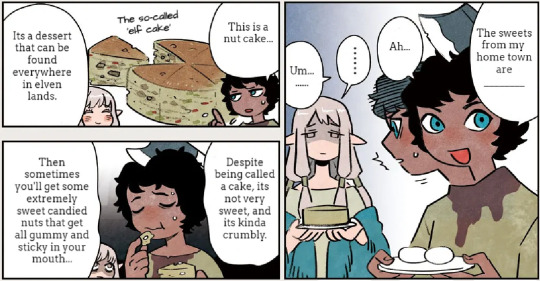
The white balls in Kabru’s dessert are very likely meant to be an Indian sweet called rasgulla (literally "syrup filled ball"). Rasgulla are a dessert popular in the eastern part of South Asia, made from ball-shaped dumplings of chhena dough, cooked in light sugar syrup. While it is near-universally agreed upon that the dessert originated in the eastern Indian subcontinent, the exact origin is disputed. Rasgulla are as culturally important to the Bengal and Odisha regions of India as Parmesan cheese is to the region of Parma in Italy.
Rasgulla are also popular in Nepal, where they are called rasbari.
KABRU’S PHYSICAL APPEARANCE

Kabru is one of several characters in Dungeon Meshi with clearly non-European features: he has brown skin and thick black/dark brown curly hair. He has almond-shaped eyes with long, dark lashes (fans like to joke that he’s wearing eyeliner). All of these are traits common to people from the Indian subcontinent. His blue eyes are not common for someone with his skin/hair color, but blue or green eyes are not unheard of in that region either.

(Indian man with blue eyes)
Blue or light eyes are often a cause for discrimination, like what Kabru experienced as a child. More on this in a moment.
Kabru is 5’7” (170cm) tall, which is short for a Northern European man (180), tall for a Nepali man (162cm), but close to the average height of Indian men (177cm). He has a slender build, which is also common for Asian people in general, and South Asian men in particular.

Compared to the European-looking tall-men in Dungeon Meshi (such as Laios, Falin, Delgal, Marcille’s father), Kabru’s facial features look more like the other Asian characters, such as Toshiro and his party.
CAN DARK-SKINNED PEOPLE HAVE BLUE EYES?
Yes. Light-colored eyes are very uncommon in parts of the world where most people have dark eyes, since dark eyes are a dominant trait in real-world human beings. That means that in order for two parents with dark eyes to have a child with light eyes, both parents need to have a recessive light-eyes gene (or for there to be an illness or genetic mutation), and that’s rare in populations that don’t have a lot of light-eyed people to begin with.
THEN WHY DO SO MANY DARK-SKINNED CHARACTERS HAVE BLUE EYES?
Anime and manga often give characters with dark skin light colored eyes instead of allowing them to have brown or black eyes, which is much more common in real life. It’s a hurtful design trope that makes many readers feel that their natural dark eyes are somehow ugly or inferior to blue eyes.
This trope is used over and over again by authors who want their characters to look “cool” and “exotic”, and for their eyes to be high-contrast to make it easier to show their emotions.
I don’t think this is what Ryoko Kui is doing in Dungeon Meshi.
UNREALISTIC HAIR AND EYE COLOR COMBOS IN ANIME
In a lot of anime/manga, blue eyes (regardless of skin color) don’t actually mean anything in the narrative, in the same way characters having green or pink hair doesn’t mean anything, the colors are non-diegetic, they don’t actually exist in the world, like the music that plays in the background without an on-screen source.
It’s an artistic shorthand to make characters visually stand out, instead of giving them all black hair and eyes like most real-life Japanese people… Which is what most anime/manga characters are meant to be: Japanese people.
Dungeon Meshi has a large cast of characters that are explicitly meant to be non-Japanese. We know this because there’s a group of characters that are Japanese, and they’re drawn differently from everyone else, they wear ethnically Japanese clothing, and have ethnically Japanese names.
Unlike other series, where eye and hair color don’t mean anything, Dungeon Meshi has no unrealistic skin, hair, or eye color combinations.
(Except for the elves, who seem to have different genetics than real world-humans. I’ll get into that another time.)
Ryoko Kui must be aware of the dark skin, blue-eyes design trope, because if she gave Kabru blue eyes just because she thought it looked good, surely she would have made some of the other Asian or dark-skinned characters have light eyes. Out of 9 Asian or dark-skinned tall-man characters, Kabru is the only one with blue eyes.
Kabru having light-colored eyes is central to his story, and Kui talks about it.
KABRU’S STORY AND WHY HIS BLUE EYES MATTER
Kabru’s father and his family tried to kill Kabru when he was born because he had blue eyes. Kabru’s mother ran away, and ended up raising Kabru by herself in Utaya. She didn’t try to return home to her own birth family, but instead struggled to raise a child completely on her own with no money or support, which implies she had no other options, due to the fear people of their region have for people with blue eyes.
This is a real thing that used to happen frequently in areas where most of the population has dark eyes, and it still happens to this day.
In a realistic story, this is logically what would happen to a character with dark skin born with blue eyes in a place like the Utaya region. It’s rare for manga or anime to show dark-skinned blue-eyed characters facing this.
WHAT IS THE “EVIL EYE”?
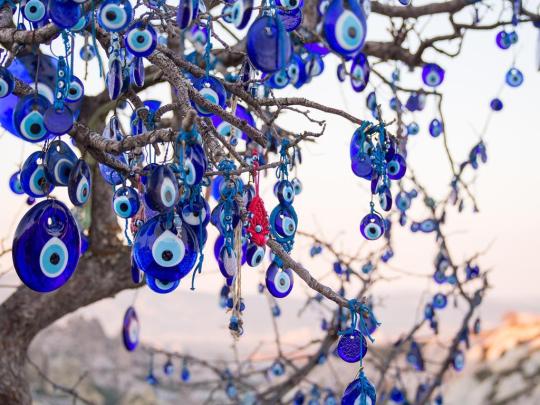
The “evil eye” is a supernatural belief in a curse brought about by a person looking at you. The belief in the evil eye has existed since prehistory, as long as 5,000 years ago. It is estimated that around 40% of the modern world's population believes in the evil eye. This concept is most common across the Mediterranean, the Balkans, the Middle East, and Central and South Asia, areas where light-colored eyes are uncommon.
In areas where light-colored eyes are rare, people with green eyes, and especially blue eyes, are thought to bestow the curse, intentionally or unintentionally. Just one look from a blue-eyed person is often considered enough to inflict a curse.
One of the most famous and widespread talismans against the evil eye is the nazar, a glass amulet featuring concentric circles in dark blue, white, light blue and black. It’s supposed to “bounce” the curse away from the wearer.
HOW DOES THIS APPLY TO KABRU?
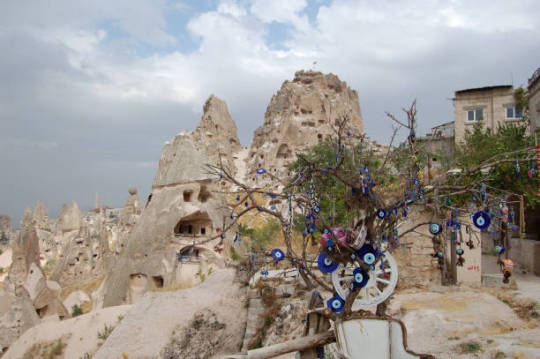
Imagine Kabru growing up in a village surrounded by people wearing and hanging talismans that look like his eyes, because the people around him think blue eyes are evil. They call his mother a witch for birthing him, and a whore because she doesn’t have a husband. Imagine parents forbidding their children from playing with or even talking to Kabru. People crossing the street to get away from him, or chasing him away by throwing rocks.
I think the reason young Kabru was able to learn how to speak some kobold is likely because he was so heavily ostracized by the other tall-men around him, the only children he could occasionally interact with in Utaya were kobolds, who might not share the same cultural superstitions that the tall-man do.
This childhood trauma, combined with Kabru’s experience of the dungeon collapse in Utaya, and being raised by an elf that treated him more like a pet than a human being, set Kabru up as a character who has never had a home where he belongs. He has been an outsider from the instant he was born, and every place he has lived treats him as an “other.”
To his father’s family, he was a curse. To his mother, although she loved him, he was a burden. To the people of Utaya, he was a monster. To the elves, he’s a tall-man baby (no matter how old he gets) with funny looking eyes, to the people on Merini Island, he’s a foreigner from the West with elven ways and education.
CONCLUSION
I wanted to write this because I know some people will see Kabru in the anime for the first time today and think "Oh, another dark skinned blue eyed character! This is a bad character design that is evidence that the author is racist at worst or ignorant at best.” And I don’t think that’s a fair assessment of Ryoko Kui’s work in Dungeon Meshi.
This isn’t to say that Ryoko Kui has never done anything wrong, or that her work couldn’t be more inclusive, or that there’s no way in which she could improve.
But there are pages and pages of artwork she’s done that shows she cares about these issues, and I think it’s worth celebrating when someone makes that kind of effort with their artwork.
ANYWAY…
If you’ve read this far, you’re very strong hahaha. I hope you enjoyed this essay. I’ll be publishing more soon when I finish my Dungeon Meshi research on the names and cultures of all the characters. Wish me luck!
#dungeon meshi#delicious in dungeon#dunmeshi#kabru#my stuff#analysis#character of color#theories#Dungeon Meshi Research
2K notes
·
View notes
Text
Dandelion News - June 1-7
Like these weekly compilations? Tip me at $kaybarr1735 or check out my Dandelion Doodles!
1. Missoula, MT Adopts Pride Flag As "Official Flag," Legally Defying Ban On Flying It

“Montana HB819 was intended to ban Pride flags from flying on city property, but had an exception for "official flags." So Missoula made the Pride flag an official flag. […] In Salt Lake City, council members moved to designate the Pride flag, the transgender flag, and others targeted by state bans as “official city flags.” Boise, Idaho, took the same approach after its state legislature enacted a similar restriction.”
2. Dilly Dally the sea turtle returns to the ocean after flipper amputation

“An adolescent loggerhead sea turtle named Dilly Dally crawled into the Atlantic Ocean Wednesday morning, months after having a front flipper amputated at a Florida turtle hospital. […] A satellite tracking device attached to Dilly Dally’s shell will allow the center and the public to follow her journey. […] All sea turtles are endangered or threatened species. “So every sea turtle that we can save and get back out there is the win for the species.””
3. Japan’s First Zero-Waste Town: Kamikatsu

“[… R]esidents are encouraged to bring their waste to a Zero Waste Centre and separate it themselves at different stations that correspond with each of the [45] waste categories. […] By 2020, the town was recycling 81 per cent of all its waste, far above Japan’s national average of 20 per cent. […] In true circular economy thinking, the first step in the town’s waste process is not disposal but reuse, with items directed to a free thrift store[….]”
4. Puerto Rico Supreme Court recognizes ‘X’ as third gender for birth certificates in landmark decision

“Puerto Rico’s Supreme Court has mandated that the government include an “X” gender marker on birth certificates in a ruling issued on Monday. A group of nonbinary Puerto Ricans filed the case, and the ruling allows for the representation of those who identify outside of the gender binary. […] “Specifically, Plaintiffs request the Court to order the Demographic Registry of Puerto Rico to modify its application to amend a Puerto Rican birth certificate, to include an option to change one’s gender marker to an ‘X.’””
5. Smallest otter in the world rediscovered in Nepal after 185-year absence

“WWF is helping to build community stewardship for the conservation of otters and their prey, raising awareness and strengthening livelihoods. […] 375 local community members have received training on traditional gear, fish breeding seasons and eco-friendly fishing practices. […] Sonaha and Tharu households have also been supported in establishing small businesses that use their local knowledge and are less reliant on the river’s resources[….]”
May 22-28 news here | (all credit for images and written material can be found at the source linked; I don’t claim credit for anything but curating.)
#hopepunk#good news#montana#pride month#pride#pride flag#us politics#sea turtles#sea turtle#turtles#turtle#veterinary#animal rescue#japan#zero waste#recycling#thrifting#upcycling#circulareconomy#puerto rico#gender#nonbinary#non binary#enby#otter#nepal#animals#nature
174 notes
·
View notes
Text

The Cabinet has approved the Marriage Equality Bill, and the draft law is expected to be submitted during the next Parliament session, which will start on December 12, said Prime Minister Srettha Thavisin.
If the draft bill is approved into law, Thailand will become the third Asian country, after Taiwan and Nepal, to recognize same-sex marriage.
The draft bill, initiated by the Move Forward Party, passed its first reading last year. However, the bill was shelved after the previous parliament was dissolved ahead of the May general election.
In addition to the Marriage Equality Bill, Srettha promised that the government would also consider a bill allowing transgender Thais to change their official gender registrations and a bill to decriminalize prostitution.
Srettha's administration is also submitting a bid for Thailand to host the World Pride parade in 2028.
(source: thaienquirer @ x)
#queer stuff#important#thailand marriage equality#don't celebrate yet#especially where the current government is concerned but#things are moving 🤞
2K notes
·
View notes
Text

Mummified hand in Gheling monastery, Upper Mustang, Nepal (source)
147 notes
·
View notes
Photo

The Indus Valley Civilization was a cultural and political entity which flourished in the northern region of the Indian subcontinent between c. 7000 - c. 600 BCE. Its modern name derives from its location in the valley of the Indus River, but it is also commonly referred to as the Indus-Sarasvati Civilization and the Harrapan Civilization. These latter designations come from the Sarasvati River mentioned in Vedic sources, which flowed adjacent to the Indus River, and the ancient city of Harappa in the region, the first one found in the modern era. None of these names derive from any ancient texts because, although scholars generally believe the people of this civilization developed a writing system (known as Indus Script or Harappan Script) it has not yet been deciphered. All three designations are modern constructs, and nothing is definitively known of the origin, development, decline, and fall of the civilization. Even so, modern archaeology has established a probable chronology and periodization: Pre-Harappan – c. 7000 - c. 5500 BCE Early Harappan – c. 5500 - 2800 BCE Mature Harappan – c. 2800 - c. 1900 BCE Late Harappan – c. 1900 - c. 1500 BCE Post Harappan – c. 1500 - c. 600 BCE The Indus Valley Civilization is now often compared with the far more famous cultures of Egypt and Mesopotamia, but this is a fairly recent development. The discovery of Harappa in 1829 CE was the first indication that any such civilization existed in India, and by that time, Egyptian hieroglyphics had been deciphered, Egyptian and Mesopotamian sites excavated, and cuneiform would soon be translated by the scholar George Smith (l. 1840-1876 CE). Archaeological excavations of the Indus Valley Civilization, therefore, had a significantly late start comparatively, and it is now thought that many of the accomplishments and “firsts” attributed to Egypt and Mesopotamia may actually belong to the people of the Indus Valley Civilization. The two best-known excavated cities of this culture are Harappa and Mohenjo-daro (located in modern-day Pakistan), both of which are thought to have once had populations of between 40,000-50,000 people, which is stunning when one realizes that most ancient cities had on average 10,000 people living in them. The total population of the civilization is thought to have been upward of 5 million, and its territory stretched over 900 miles (1,500 km) along the banks of the Indus River and then in all directions outward. Indus Valley Civilization sites have been found near the border of Nepal, in Afghanistan, on the coasts of India, and around Delhi, to name only a few locations. Between c. 1900 - c. 1500 BCE, the civilization began to decline for unknown reasons. In the early 20th century CE, this was thought to have been caused by an invasion of light-skinned peoples from the north known as Aryans who conquered a dark-skinned people defined by Western scholars as Dravidians. This claim, known as the Aryan Invasion Theory, has been discredited. The Aryans – whose ethnicity is associated with the Iranian Persians – are now believed to have migrated to the region peacefully and blended their culture with that of the indigenous people while the term Dravidian is understood now to refer to anyone, of any ethnicity, who speaks one of the Dravidian languages. Why the Indus Valley Civilization declined and fell is unknown, but scholars believe it may have had to do with climate change, the drying up of the Sarasvati River, an alteration in the path of the monsoon which watered crops, overpopulation of the cities, a decline in trade with Egypt and Mesopotamia, or a combination of any of the above. In the present day, excavations continue at many of the sites found thus far and some future find may provide more information on the history and decline of the culture.
151 notes
·
View notes
Text









Phaeophyscia hispidula
Whiskered shadow lichen
While lichens are not commonly consumed, there are a few areas where some lichen species are eaten. Nepal actually has a long history of lichen cuisine, and P. hispidula is to this day harvest for commercial sale and eaten. This foliose lichen has a lobes which are gray/gray-brown when dry and light green when wet--a characteristic commonly shared amongst members of its genus. The lower surface of the lobes is black, with prominent black, white-tipped rhizines which stick out along the lobe margins. The lobe margins and occasionally lobe surface are dotted with pustule-like soralia producing granular or isidioid soredia. P. hispidula rarely produces apothecia, which have rhizinate margins and dark brown or black discs. It grows on both bark and rock in boreal and montane habitats.
images: source | source | source
info: source | source | source
#lichen#lichens#lichenology#lichenologist#mycology#ecology#biology#symbiosis#symbiotic organisms#algae#life science#environmental science#environment#science#natural science#natural#nature#beautiful nature#weird nature#Phaeophyscia hispidula#Phaeophyscia#I'm lichen it#daily lichen post#lichen subscribe#lichen a day#nepal
417 notes
·
View notes
Text

The Himalayas, with Mount Everest at top center, captured by satellite at a low angle. The range contains some of Earth’s highest peaks, including over 100 that exceed 23,600 feet (7,200 meters) in elevation. The Himalayas abut or cross five countries: Bhutan, India, Nepal, China, and Pakistan.
Source imagery: Planet
378 notes
·
View notes
Text
"This decade has been one of the most positive for news about tiger conservation of any since conservation science began in earnest, and a highlight must be this mother tiger and her two cubs sighted in Western Thailand, the first such sighting in more than 10 years of close monitoring.
Tigers are stable or increasing across their entire remaining strongholds, including China, Russia, India, Nepal, Bangladesh, Bhutan, and now Thailand—the only Southeast Asian country to see measurable increases in tiger population over the last 12 years.
There may now be as many as 190 tigers in the country, up from 46 logged in a population survey in 2007.
The sight of the mother and her cubs, in the Salak Phra Wildlife Sanctuary, part of the sprawling Western Forest Complex of Thungyai–Huai Kha Khaeng Wildlife Sanctuaries that stretch across 2,400 square miles, is a sign that Thailand’s conservation efforts are really working; not only are tigers breeding outside of core areas, but that must therefore mean there is enough large game, like sambar deer, to feed them.
“This is a big news for us,” said Rattapan Pattanarangsan, the conservation program manager at the Thai chapter of Panthera, a renowned wildcat conservation NGO. “…now we are the source, we can produce tigers from our place. That means our place is safe enough, and has enough prey for the mothers to eat and breed.”
Neighboring Laos, Cambodia, and Vietnam haven’t been able to make meaningful progress in restoring their tigers, and if they ever needed a few individual animals, Thailand now has a stable, growing population that is adapted to similar forest conditions.
Pattanarangsan told The Guardian that creative efforts to stop poachers, such as by working together with ranchers to place early warning cameras on forest trails have worked significantly.
Reductions in commercial bamboo harvesting have also reduced human-tiger conflict, and the animals look poised to continue flourishing in the western rainforests of the country."
-via Good News Network, January 8, 2024
#tiger#tigers#wildlife#conservation#endangered species#thailand#thai#poachers#big cats#good news#hope#hope posting#baby animals#tiger cub
887 notes
·
View notes
Text
Exciting news is brewing in the world of cinema: Hollywood stars Tom Hiddleston and Willem Dafoe are in Kathmandu, Nepal, to begin work on the highly anticipated biographical drama Tenzing.
Insiders suggest they’re gearing up to bring Tenzing Norgay Sherpa extraordinary story to life.
Jennifer Peedom is at the helm, with spring 2025 marked as the start of principal photography, and Kathmandu, rich in mountaineering history, is the perfect backdrop.
Here’s what we know so far.
The Insider Scoop
According to our source in India, Tom Hiddleston, who’ll play Sir Edmund Hillary, and Willem Dafoe, cast as Colonel John Hunt, are in Kathmandu to kick off pre‑production and possibly even some early filming.
This fits the spring 2025 timeline that the team announced.
While the production hasn’t made a formal announcement yet, word is that Tenzing is moving full steam ahead in Nepal.
About the Film: Tenzing
Tenzing celebrates Tenzing Norgay, the Nepalese‑Indian Sherpa who, alongside Sir Edmund Hillary, became one of the first people to summit Mount Everest on May 29, 1953.
The filmmakers aim to spotlight his remarkable journey, honor his cultural heritage, and highlight the vital role Sherpas play in mountaineering, stories that often get glossed over.
See‑Saw Films is producing, with support from Apple Original Films, promising both breathtaking visuals and a narrative with real heart.
The Cast
Tom Hiddleston as Sir Edmund Hillary: Best known as Loki in the Marvel universe, Hiddleston will portray the determined explorer who forged an iconic partnership with Norgay.
Willem Dafoe as Colonel John Hunt: The Oscar‑nominated actor (seen in Platoon and Poor Things) takes on the role of the expedition leader whose strategy made the historic ascent possible.
Tenzing Norgay: Casting for the legendary Sherpa is still under wraps, with the production committed to finding someone who can truly embody his spirit.
Casting for Tenzing Norgay
One intriguing possibility floating around is Tenzing Norgay Trainor, the actor and grandson of the climber, known for his work in Disney’s Liv and Maddie and Netflix’s Abominable.

His personal connection could bring an extra layer of authenticity, though the filmmakers have yet to confirm any names.
The Director
Jennifer Peedom, an Australian filmmaker who earned the Sherpa community’s trust through her documentaries Sherpa (2015) and Mountain (2017), is directing.
With a screenplay by Luke Davies (Lion), you can expect an approach that’s both respectful and deeply moving.
Why Kathmandu?
Kathmandu isn’t just a convenient shooting spot; it’s the heart of this story.
Roughly 160 kilometers from Everest Base Camp, its bustling markets, ancient temples like Boudhanath Stupa and Pashupatinath, and easy access to the Himalayas make it ideal for scenes depicting Norgay’s early life and the expedition’s final preparations.
If our intel is right, the cast and crew are already in full swing.
Hollywood’s History with Nepal
Nepal’s cinematic appeal isn’t new: Doctor Strange (2016) highlighted its mystical temples and winding streets, while Everest (2015) captured the raw power of the mountain itself.
With Tenzing, audiences worldwide will likely get another breathtaking glimpse of the Himalayas, and perhaps plan their own journeys there.
Production Details
Filming is slated to span both Nepal and New Zealand, with Kathmandu as the central hub.
Producers Liz Watts, Emile Sherman, and Iain Canning, known for their attention to detail, are overseeing the project, and Norbu Tenzing, the climber’s son, is on board as an executive producer to ensure cultural alignment.
While our source hints at significant activity already underway, the team seems determined to keep specifics close to the vest, perhaps to avoid crowds during filming.
#interesting speculation about who might play Tenzing#his IG seems to show he's very interested in his grandfather's story#Not sure if this is just speculation though#tom hiddleston#willem dafoe#tenzing#pre-production?
106 notes
·
View notes
Text
Urf Darasing
About a week ago I posted a couple of pictures including this picture of Caitriona in Nepal

I found the picture via a story on the IG of Willem Dafoe, a repost of the original poster Anup Khadka.
As I thought to recognize Caitriona, but since the picture was a bit grainy, and she didn't look into the camera on this one, I was fairly sure it was Caitriona though, but I looked for confirmation. Asked some friends, some were positive it was her, others not entirely sure. So I held off posting it, and decided to contact Anup Khadka about it. I was also curious, where this picture was taken, as it didn't look like a film set but more like a theater. Unfortunately Anup didn't answer me right away, I waited a day or so.
Since I had no answer I posted it like it was, just the picture and no further information. Meanwhile Anup saw my message and contacted me and we had a nice chat, exchanging some information.
He confirmed it was Caitriona and told me she was visiting a play at the Mandela Theater in Thapagaun together with Willem Dafoe. They were watching the play Urf Darasing.
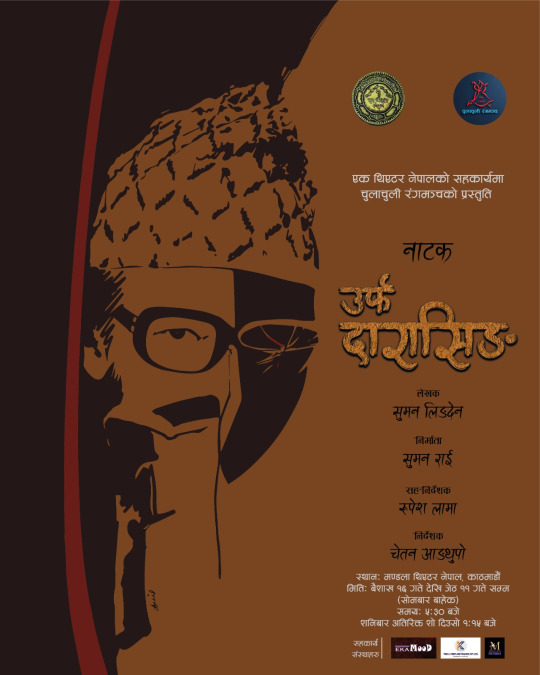
Based on oral history, Urfa Darasingh follows the story of a man named Darasingh — a fictional character shaped by the socio-political turbulence of the Panchayat regime. The play delves into thought-provoking questions such as: How did he become Darasingh? What forces molded him into who he became? Through powerful performances and evocative storytelling, the drama critiques systemic corruption and the decay of leadership, arguing that while systems may not be inherently flawed, failed leaders continue to produce “Darasinghs” even today. The play acts as a mirror to ongoing societal issues, resonating strongly with contemporary audiences.

The play is written by Suman Lingden, produced by Suman Rai, with Manorath Pokhrel as co-producer and Rupesh Lama as associate director.

source
After watching the play Willem Dafoe and Caitriona took some pictures with the cast. With the information graciously shared with me by Anup, I was able to find some more and better pics from the event.

Sherpa Dawa Lama Karma (FB)

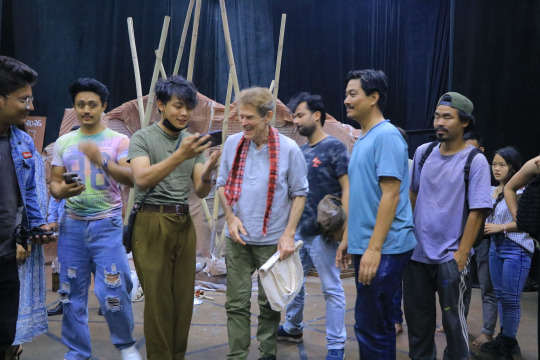
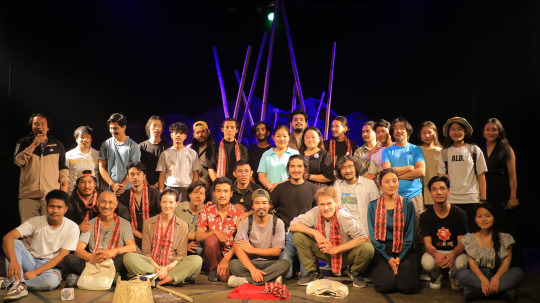
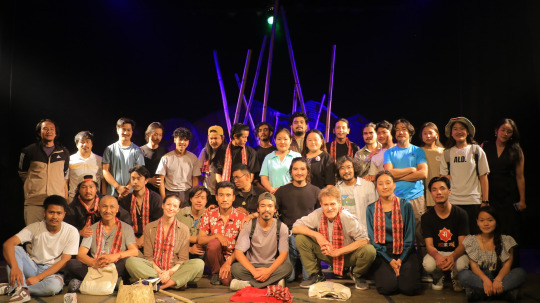
Ajaya Lama (FB)
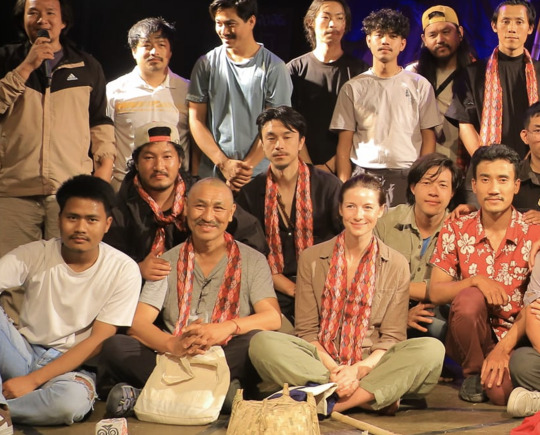
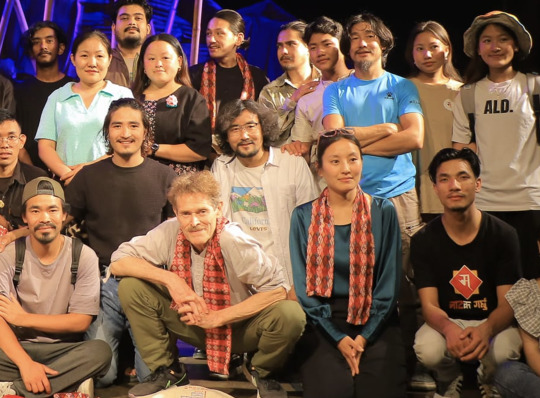

Many thanks to Anup Khadka for providing the information. I hope one day your dreams come true to get abroad and expand your talents 🧡
61 notes
·
View notes
Text
Moth Of The Day #255
Oriental Purple Owl-moth
Erebus albicinctus
From the erebidae family. They can be found in Taiwan, India, Nepal, Bangladesh, Thailand and Indonesia.
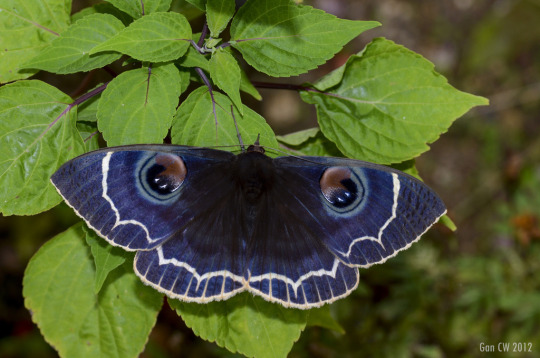
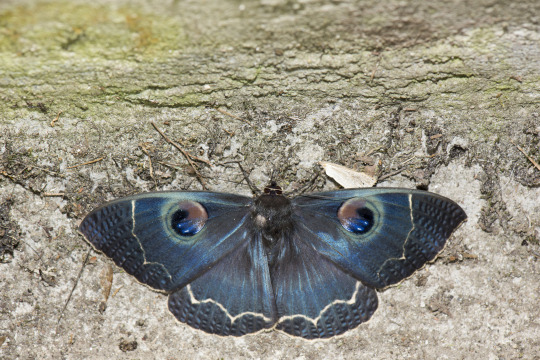
Image sources: [1] [2]
also it's my birthday hi
#moth#moths#lepidopterology#lepidoptera#nature#pretty moth#bugs#insect#moth of the day#motd#bug#lepidoptery#entomology#bugblr#lepidopterist#erebus albicinctus#oriental purple owl moth#oriental purple owl-moth#asian moth#beautiful moth
752 notes
·
View notes